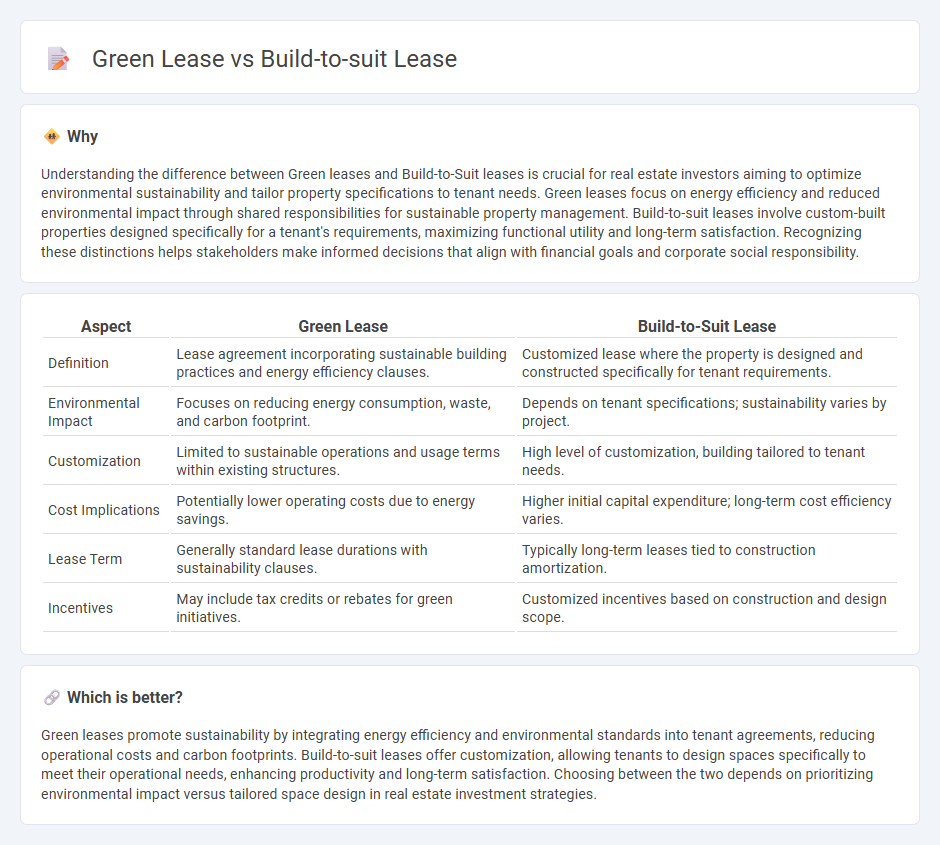
Green leases prioritize sustainable building practices and shared responsibilities for energy efficiency between landlords and tenants, promoting reduced environmental impact. Build-to-suit leases involve customized construction tailored to the tenant's specific needs, often resulting in higher initial investment but optimized space utilization. Explore the differences between these leasing options to determine the best fit for your real estate strategy.
Why it is important
Understanding the difference between Green leases and Build-to-Suit leases is crucial for real estate investors aiming to optimize environmental sustainability and tailor property specifications to tenant needs. Green leases focus on energy efficiency and reduced environmental impact through shared responsibilities for sustainable property management. Build-to-suit leases involve custom-built properties designed specifically for a tenant's requirements, maximizing functional utility and long-term satisfaction. Recognizing these distinctions helps stakeholders make informed decisions that align with financial goals and corporate social responsibility.
Comparison Table
| Aspect | Green Lease | Build-to-Suit Lease |
|---|---|---|
| Definition | Lease agreement incorporating sustainable building practices and energy efficiency clauses. | Customized lease where the property is designed and constructed specifically for tenant requirements. |
| Environmental Impact | Focuses on reducing energy consumption, waste, and carbon footprint. | Depends on tenant specifications; sustainability varies by project. |
| Customization | Limited to sustainable operations and usage terms within existing structures. | High level of customization, building tailored to tenant needs. |
| Cost Implications | Potentially lower operating costs due to energy savings. | Higher initial capital expenditure; long-term cost efficiency varies. |
| Lease Term | Generally standard lease durations with sustainability clauses. | Typically long-term leases tied to construction amortization. |
| Incentives | May include tax credits or rebates for green initiatives. | Customized incentives based on construction and design scope. |
Which is better?
Green leases promote sustainability by integrating energy efficiency and environmental standards into tenant agreements, reducing operational costs and carbon footprints. Build-to-suit leases offer customization, allowing tenants to design spaces specifically to meet their operational needs, enhancing productivity and long-term satisfaction. Choosing between the two depends on prioritizing environmental impact versus tailored space design in real estate investment strategies.
Connection
Green leases and build-to-suit leases intersect through their focus on sustainability and customization in real estate agreements. Green leases incorporate environmental performance clauses that promote energy efficiency, while build-to-suit leases allow tenants to influence the design and construction to meet specific eco-friendly standards. This connection drives the adoption of sustainable building practices that align tenant needs with long-term environmental goals.
Key Terms
Customization
Build-to-suit leases offer tenants complete customization of the property to meet specific operational needs before construction, ensuring a tailored facility aligned with business requirements. Green leases incorporate sustainability clauses that promote energy efficiency and environmental responsibility, allowing tenants to customize their space while adhering to green building standards. Explore the differences and benefits of both lease types to determine the best fit for your project's customization and sustainability goals.
Sustainability
Build-to-suit leases enable tenants to customize properties with sustainable features such as energy-efficient systems and renewable materials, fostering lower carbon footprints. Green leases incorporate clauses promoting environmental performance and shared responsibility for sustainability goals between landlords and tenants. Explore the benefits and applications of both lease types to enhance your commercial property's sustainability strategy.
Operating Expenses
Build-to-suit leases typically allocate operating expenses directly to tenants, allowing them to customize and control costs related to maintenance, utilities, and property management. Green leases incorporate sustainability clauses that promote energy efficiency and shared responsibility for operating expenses, often resulting in reduced utility costs and environmental impact for both landlords and tenants. Discover how these lease structures influence financial planning and environmental goals in commercial real estate.
Source and External Links
Build-to-Suit Leases: Pros and Cons of BTS Leases - This article discusses how build-to-suit leases allow businesses to customize new commercial spaces without using their own capital, with the developer covering construction costs and leasing the property back to the business.
The Ins and Outs of Build-to-Suits - This blog post explains the process and benefits of build-to-suit leases, including preserving capital and committing to long-term leases, and discusses different approaches such as developer-led and investor-led models.
Build-to-Suit Development: A Comprehensive Guide - This guide provides an overview of build-to-suit arrangements, highlighting the mutual benefits for landlords and tenants, where the landlord develops the property according to the tenant's specifications and retains ownership.
 dowidth.com
dowidth.com